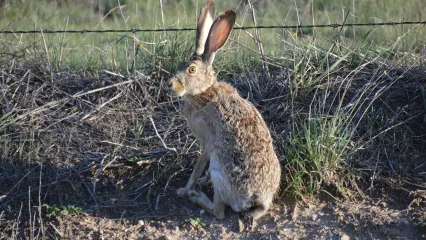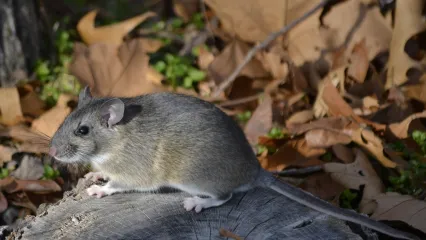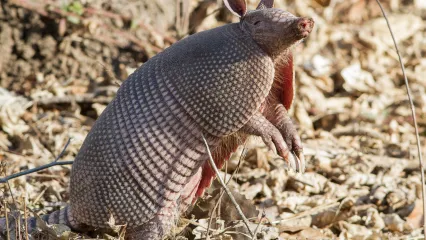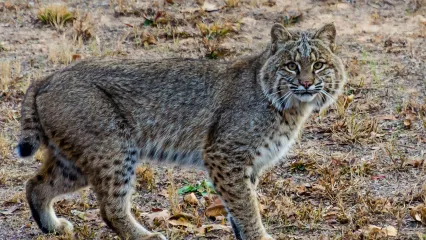
Description
The black-tailed jackrabbit, the only jack rabbit occurring in Oklahoma, is not really a rabbit but a hare. It has a buff gray body above, white below, and a black stripe down the center of its back. Its most distinguishable features are its black-tipped ears, which measure between five to seven inches in length, as well as its black-top tail.
Pound for pound. the black-tailed jackrabbit is the greatest of all Oklahoma long-jump champions.
Black-tailed jackrabbits can be seen statewide, but they are most common in western Oklahoma. They got their name from early settlers of the southwest who called them "jackass rabbits" because of their large ears. Today, they are commonly called jacks, black-tailed jacks and blacktails.
Because of their advanced sense of smell. large rotating ears, and eyes set far back on their heads. black-tailed jackrabbits are superbly adapted to life in open areas Ever alert, jackrabbits rest in shallow depressions beneath small trees or shrubs during the day. They only leave their hiding places toward evening.
When flushed from cover, jackrabbits rely on their speed and jumping ability to escape predators. They can leap distances of up to 20 feet and run as fast as 40 miles per hour, often sprinting in a zig-zag pattern. When running, they flash the white underside of their tails to warn other jackrabbits and jump exceptionally high every few leaps to see their surroundings and confuse their pursuer.
Black-tailed jackrabbits eat twigs and bark of woody plants during fall and winter, and grasses and weeds during spring and summer. They get most of their water from succulent plants. Jackrabbits eat constantly and are particularly fond of alfalfa.
When populations are at average numbers, black-tailed jackrabbits may complement livestock grazing. They eat grasses that are undesirable to cattle, as well as some poisonous plants, thus reducing poisonous plant cover. On the other hand, large jackrabbit populations can compete with cattle and overgraze ranges, but its need for high visibility generally leads to higher densities in range land that is in fair condition. The best way to minimize the competition between black-tailed jackrabbits and livestock for forage is to keep range lands in good to excellent condition.
Black-tailed jackrabbits are a symbol of western grasslands. When afield, hunters and nun-hunters alike are quick to smile at the sight of the leaping long-jumper with the colossal ears sprinting across the landscape. Whether providing breakfast for a hungry coyote or exercise for a bobcat, jackrabbits play an important role in Oklahoma's wildlife community.
Size
A large mammal weighing between four and seven pounds, the black-tailed jackrabbit (Lepus californicus) is not really a rabbit, but a hare. It has a buff gray body above, white below, and a black stripe down the center of its back. Its most distinguishable features are its black-tipped ears, which measure between five to seven inches in length, as well as its black-top tail. 20-23 inches in total length.
Habitat
Black-tailed jackrabbits have been documented across most of the western ¾ of the state, but they are most common in western Oklahoma. Adapted to Oklahoma’s open landscapes, black-tailed jackrabbits live in low, brushy areas with vegetation that is typically less than three feet high. They live in a world in which 95% of the landscape is under this three-foot mark. Jackrabbits often prefer grazed pastures with a few shrubs or small trees.
They often prefer grazed pastures with a few shrubs or small trees. This habitat makes it easier to spot predators such as coyotes. foxes, badgers, bobcats, and red-tailed hawks, for which they are favorite prey.
Life Cycle
Because of their large rotating ears, eyes set far back on their heads and their advanced sense of smell, black-tailed jackrabbits are superbly adapted to life in open areas. Ever alert, jackrabbits rest in shallow depressions beneath small trees or shrubs during the day. Unlike true rabbits, whose young are born helpless and without fur, jackrabbit young are born fully furred with open eyes and can hop and leave the nest within a few hours after birth.
Jackrabbit populations experience drastic fluctuations every three to 10 years. Populations increase to great abundance and then suddenly decrease for unknown reasons, but disease, food shortages or an increase in predators may contribute. In some years. nearly 90 percent of the western population of blacktails may perish, but they recover quickly because they are such prolific breeders. A female jackrabbit may bear three to four litters per year with up to eight young per litter. Leverets reach adult size and are able to breed in about seven to eight months.


